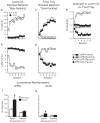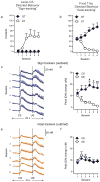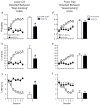A selective role for dopamine in stimulus-reward learning
- PMID: 21150898
- PMCID: PMC3058375
- DOI: 10.1038/nature09588
A selective role for dopamine in stimulus-reward learning
Abstract
Individuals make choices and prioritize goals using complex processes that assign value to rewards and associated stimuli. During Pavlovian learning, previously neutral stimuli that predict rewards can acquire motivational properties, becoming attractive and desirable incentive stimuli. However, whether a cue acts solely as a predictor of reward, or also serves as an incentive stimulus, differs between individuals. Thus, individuals vary in the degree to which cues bias choice and potentially promote maladaptive behaviour. Here we use rats that differ in the incentive motivational properties they attribute to food cues to probe the role of the neurotransmitter dopamine in stimulus-reward learning. We show that intact dopamine transmission is not required for all forms of learning in which reward cues become effective predictors. Rather, dopamine acts selectively in a form of stimulus-reward learning in which incentive salience is assigned to reward cues. In individuals with a propensity for this form of learning, reward cues come to powerfully motivate and control behaviour. This work provides insight into the neurobiology of a form of stimulus-reward learning that confers increased susceptibility to disorders of impulse control.
Conflict of interest statement
The authors declare no competing financial interests.
Figures




Comment in
-
Reward: a dopaminergic dichotomy.Nat Rev Neurosci. 2011 Feb;12(2):64. doi: 10.1038/nrn2981. Nat Rev Neurosci. 2011. PMID: 21309094 No abstract available.
References
-
- Schultz W. Behavioral theories and the neurophysiology of reward. Annu Rev Psychol. 2006;57:87–115. - PubMed
-
- Wise RA. Dopamine, learning and motivation. Nat Rev Neurosci. 2004;5 (6):483–494. - PubMed
-
- Day JJ, Roitman MF, Wightman RM, Carelli RM. Associative learning mediates dynamic shifts in dopamine signaling in the nucleus accumbens. Nat Neurosci. 2007;10 (8):1020–1028. - PubMed
-
- Schultz W, Dayan P, Montague PR. A neural substrate of prediction and reward. Science. 1997;275 (5306):1593–1599. - PubMed
Publication types
MeSH terms
Substances
Grants and funding
- F32-DA24540/DA/NIDA NIH HHS/United States
- P01 DA021633/DA/NIDA NIH HHS/United States
- T32 DA007278/DA/NIDA NIH HHS/United States
- R37 DA004294/DA/NIDA NIH HHS/United States
- F32 DA024540/DA/NIDA NIH HHS/United States
- R00 MH085859/MH/NIMH NIH HHS/United States
- R01 MH079292/MH/NIMH NIH HHS/United States
- R01-DA027858/DA/NIDA NIH HHS/United States
- 5P01-DA021633-02/DA/NIDA NIH HHS/United States
- R01-MH079292/MH/NIMH NIH HHS/United States
- R01 DA027858/DA/NIDA NIH HHS/United States
- R37-DA04294/DA/NIDA NIH HHS/United States
- T32-DA07278/DA/NIDA NIH HHS/United States
LinkOut - more resources
Full Text Sources
Other Literature Sources

